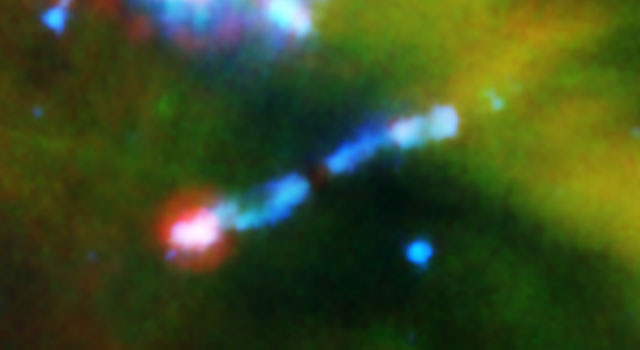[/caption]
The Spitzer Space Telescope has spied water in a cloud of gas and dust around a nascent star. That’s interesting in itself, but even more remarkable, the water is being blasted apart by the young star’s laser-like jets. Spitzer’s spectrometer was used to get a better look at these jets and analyze the jet’s molecules. To the astronomers’ surprise, Spitzer picked up the signature of rapidly spinning fragments of water molecules, called hydroxyl, or OH. “This is a truly unique observation that will provide important information about the chemistry occurring in planet-forming regions, and may give us insights into the chemical reactions that made water and even life possible in our own solar system,” said Achim Tappe, of the Harvard-Smithsonian Center for Astrophysics, Cambridge, Mass.
A young star forms out of a thick, rotating cloud of gas and dust. Like the two ends of a spinning top, powerful jets of gas emerge from the top and bottom of the dusty cloud. As the cloud shrinks more and more under its own gravity, its star eventually ignites and the remaining dust and gas flatten into a pancake-like disk, from which planets will later form. By the time the star ignites and stops accumulating material from its cloud, the jets will have died out.
Tappe and his colleagues used Spitzer’s infrared eyes to cut through the dust surrounding the star, called HH 211-mm, to analyze the jets. The astronomers were surprised to see water molecules in the data. But the results showed the hydroxyl molecules have absorbed so much energy (through a process called excitation) that they are rotating around with energies equivalent to 28,000 Kelvin (27,700 degrees Celsius). This far exceeds normal expectations for gas streaming out of a stellar jet. Water, which is abbreviated H2O, is made up of two hydrogen atoms and one oxygen; hydroxyl, or OH, contains one oxygen and one hydrogen atom.
The results reveal that the jet is ramming its head into a wall of material, vaporizing ice right off the dust grains it normally coats. The jet is hitting the material so fast and hard that a shock wave is also being produced.
“The shock from colliding atoms and molecules generates ultraviolet radiation, which will break up water molecules, leaving extremely hot hydroxyl molecules,” said Tappe.
Tappe said this same process of ice being vaporized off dust occurs in our own solar system, when the sun vaporizes ice in approaching comets. In addition, the water that now coats our world is thought to have come from icy comets that vaporized as they rained down on a young Earth. This discovery provides a better understanding of how water — an essential ingredient for life as we know it — is processed in emerging solar systems.
Source: JPL


Golly, found water in a Star and they are unable to find water on Mars. What to believe!?
Oops. Small typo that you might want to fix:
“Water, which is abbreviated H2O, is made up of two oxygen atoms and one hydrogen…”
Nope. It’s the other way around. @ hydrogens & 1 oxygen.
Great and now I have a typo. 🙂
I meant: 2 hydrogens & 1 oxygen.
Thanks! Its been fixed. From your name, I assume that means your good with numbers…
Nancy
and I”m bad with spelling — that’s “you’re”
Our Sun (a star) was placed there as our “restart” button…so if nature decides that our time has run out, then the Sun, regardless of it’s age, will blast us out of existence, including our water :D. The image you showed us is simply showing us nature in action.
If it has a jet, it may not be a young star, but must be some form of object that can emit a jet. Now it then becomes a moot point that the only objects that emit jets are forms of black holes. (Remember that a Planetary Nebula emits a fan from each end). So now we have a jet emitting water molecules.
Hmmm! So now we have to think about how come a form of black hole, which is supposed to deconstruct everything entering it, can still have a source of water?
All will be explained soon.
This is one of those things many people have been wanting to see for a long time. It is so hard to wrap around the comet ice theory of ocean creation. With the amount of water all over Earth, its tough to imagine how many comets it would have taken, and the amount of water in the area would have needed to be there to form on them as well.
Now… if we can just find a pocket of nitrogen somewhere, we may be able to answer some other questions!